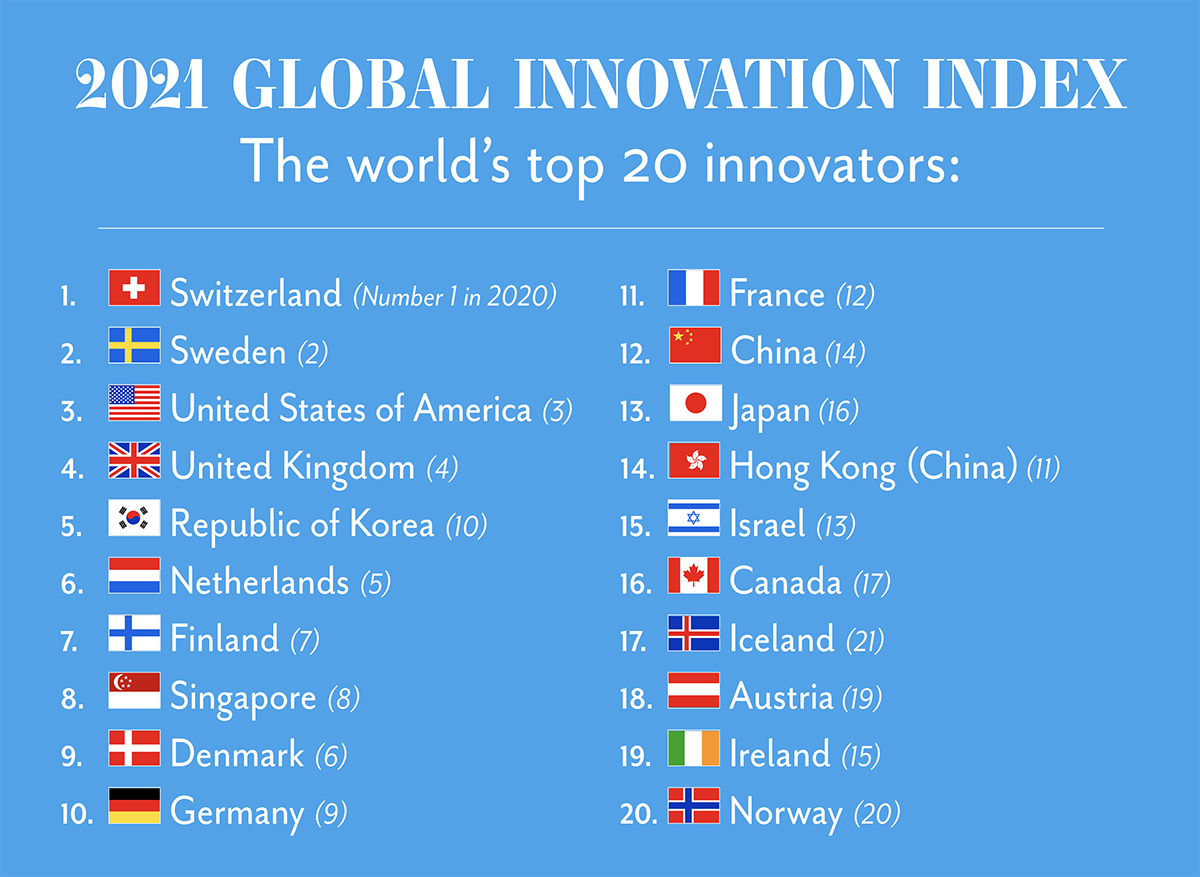Language
You can read the magazine in one of the following languages
Innovation is the creation of new value for the world. It’s the transformation of existing conditions into better ones. And it’s a high-caliber driver of increased productivity. But even more, for countries around the globe, innovation is an essential component of resilience and a vital contributor to economic growth in the face of COVID-19 – and something brands can learn a thing or two from.
Amid the crisis, governments and enterprises in many parts of the world have scaled up their investments in innovation as the Global Innovation Index (GII) 2021 has shown, highlighting the notion that new ideas are absolutely critical for overcoming the pandemic and for ensuring future sustainability and growth.
In its annual ranking of the world’s economies on innovation capacity and output, the GII shows that only a handful of economies, mostly high-income, consistently dominate the ranks. However, some middle-income economies like China, Turkey, India and the Philippines are catching up, transforming the innovation landscape.
Perhaps more insightful though is the fact that the geography of global innovation is changing unevenly. “The GII shows that although emerging economies often find it challenging to steadily improve their innovation systems, a few middle-income economies have managed to catch up in innovation with their more developed peers,” says Soumitra Dutta, Former Dean and Professor of Management at Cornell University in the US.
There’s no one-size-fits-all recipe to innovative success.
“These emerging economies, among other things, have been able to successfully complement their domestic innovation with international technology transfer, develop technologically dynamic services that can be traded internationally, and ultimately, have shaped more balanced innovation systems.”
Collectively known as brain circulation, this phenomenon of turning a brain drain into a brain bank is all about the inexorable transfer of human capital – the very thing that’s being seen to a similar extent in organizations worldwide in the Great Resignation.
So, just as countries need an innovation toolkit that will provide the skills and strategies needed to ensure their sustainability and competitive edge, so too does your business. Fill up yours with these six, expert-backed tactics that the most innovative countries employ to ensure your brand’s ongoing success, come what may.

SIX TACTICS OF THE MOST INNOVATIVE NATIONS:
Sustained investments: According to a recent McKinsey report, companies that invested in innovation delivered superior growth and performance post-crisis, outperforming peers that didn’t invest at all or as heavily. Equally as important is the length and continuity of investment. Research shows that a sustained investment in innovation is more effective than stop–start splurges. As innovation is an intrinsically human enterprise, continuous investments in human capital by way of training, education and benefits can also pay off in dividends, sparking new ideas that can help your brand in areas regarding economic growth, productivity and profitability.
Facilitate collaboration: There’s something to be said about having an integrated framework between nations to support innovation in terms of researchers, funding streams for research, and the intellectual property that underpins it all. While it may seem like a nation has enough resources to go it alone, research consistently shows that the best innovators are those that are integrated into the global marketplace and active collaborators with their peers around the world. Take Switzerland, for instance, which isn’t a member of the European Union (EU) but still works extensively with EU nations on various projects.
Make space: Just as collaboration is necessary, providing enough space for innovation to happen in the first place is equally key. This can be achieved with the right incentives and space to safely explore and trial new ideas. Simply put, developing a ‘freedom to operate’ mentality challenges the status quo and encourages innovation.
Embrace diversity: Research has shown that diversity can make companies more innovative and agile while improving financial performance, particularly in technology industries where women in the workforce and leadership teams often result in better overall performance. The nations that boast the most diverse labor forces are Norway, the Netherlands, the US and Canada – unsurprisingly, all countries found in GII’s 2021 list.
Dedicated teams: Countries like Chile, Ghana, Honduras and the UK have established government agencies, councils and organizations that are specifically responsible for innovation. When it comes to your company, innovation should be the responsibility of everyone, but it’s unrealistic to expect employees to achieve this blindly. And that’s where the innovation team comes in, behaving as a source of guidance that facilitates company-wide involvement.
Leverage data: Colombia, the EU, Mexico, Pakistan and Taiwan all have initiatives to leverage open data as a platform for innovation. In Taiwan specifically, events such as Hackathons, Data Jams and Datapaloozas are held regularly to stimulate open innovation. Data is the new currency and if your company isn’t using it correctly, you could be missing out on a lot of valuable insights.
At the end of the day, it’s worth noting that your brand’s innovation strategy needs to be custom-fit to your specific competitive needs – there’s no one-size-fits-all recipe to innovative success. It’s a balancing act, but employing the right innovation strategy is vital to ongoing success for countries and businesses alike.



